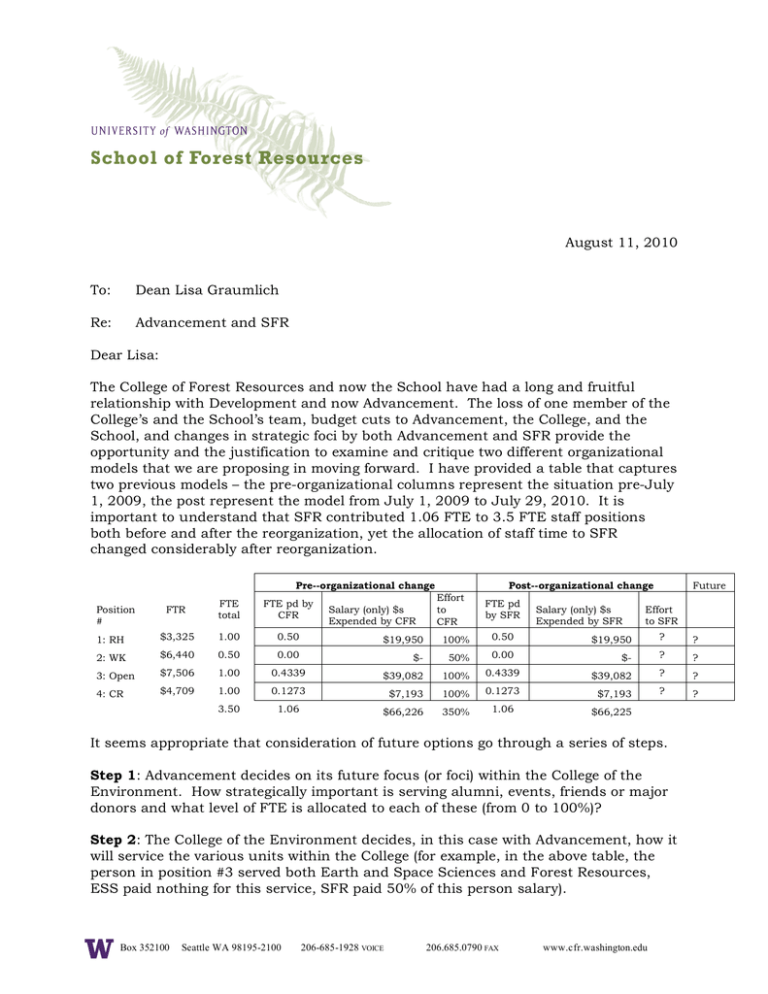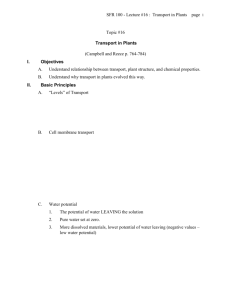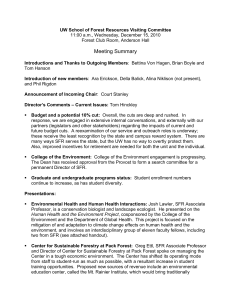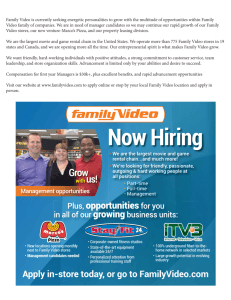advertisement

August 11, 2010 To: Dean Lisa Graumlich Re: Advancement and SFR Dear Lisa: The College of Forest Resources and now the School have had a long and fruitful relationship with Development and now Advancement. The loss of one member of the College’s and the School’s team, budget cuts to Advancement, the College, and the School, and changes in strategic foci by both Advancement and SFR provide the opportunity and the justification to examine and critique two different organizational models that we are proposing in moving forward. I have provided a table that captures two previous models – the pre-organizational columns represent the situation pre-July 1, 2009, the post represent the model from July 1, 2009 to July 29, 2010. It is important to understand that SFR contributed 1.06 FTE to 3.5 FTE staff positions both before and after the reorganization, yet the allocation of staff time to SFR changed considerably after reorganization. FTR FTE total FTE pd by CFR FTE pd by SFR 1: RH $3,325 1.00 0.50 100% 0.50 2: WK $6,440 0.50 0.00 50% 0.00 3: Open $7,506 1.00 0.4339 4: CR $4,709 1.00 0.1273 3.50 1.06 Position # Pre--organizational change Effort Salary (only) $s to Expended by CFR CFR $19,950 $- Post--organizational change Salary (only) $s Expended by SFR Future Effort to SFR ? ? ? ? ? ? $19,950 $- 100% 0.4339 $39,082 ? $7,193 100% 0.1273 $7,193 ? $66,226 350% 1.06 $66,225 $39,082 It seems appropriate that consideration of future options go through a series of steps. Step 1: Advancement decides on its future focus (or foci) within the College of the Environment. How strategically important is serving alumni, events, friends or major donors and what level of FTE is allocated to each of these (from 0 to 100%)? Step 2: The College of the Environment decides, in this case with Advancement, how it will service the various units within the College (for example, in the above table, the person in position #3 served both Earth and Space Sciences and Forest Resources, ESS paid nothing for this service, SFR paid 50% of this person salary). Box 352100 Seattle WA 98195-2100 206-685-1928 VOICE 206.685.0790 FAX www.cfr.washington.edu Knowing answers to these two steps will allow us to proceed to Step 3. Step 3: Selecting the future configuration of advancement in Forest Resources. Let me offer (1) some guiding assumptions for evaluating some proposed alternatives and (2) two alternatives. Guiding Assumptions: It is understood that there may not be an optimal solution to meeting all assumptions with an given model: Seek a model that 1. Demonstrates equity and fairness 2. Maintains and enhances SFR’s constituencies. A figure at the end of this letter illustrates the School’s last five quarters of support to endowments to nonendowment budgets. It is important to note that the total gifts through either path over these five quarters was 1.23 and 1.34 million, respectively. The gifts to the non-endowment budgets largely arise from the efforts of faculty, staff and friends (e.g., Arboretum Foundation, Washington Pulp and Paper Foundation, Miller Foundation, etc.). 3. Cultivates an expanded SFR constituency. 4. Represents clarity for a. Employees b. Units involved 5. Recognizes the realities of the futures of SFR and Advancement in CoENV 6. Is efficient 7. Easy to adopt 8. Least disruptive There are two organizational models that we feel that best meet our needs and address the guiding assumptions. These are: 1. SFR’s contributions to positions #1, 3 and 4 (above table) ends; SFR retains its 1.06 FTE contribution and hires an individual that serves its event and outreach needs (including assisting those of UWBG). Position #2 remains 50% and attached solely to UWBG. 2. Two advancement staff serve SFR. One with UWBG and one with SFR. Individuals would answer to Advancement, but be housed in SFR/UWBG and be co-supervised by Advancement/CoENV and SFR. The individual assigned to SFR would have to be able to deal with a diverse set of assignments. Advancement and CoENV contribute 1.0 FTE, SFR contributes 1.0 FTE. Of these two, the second would be preferred. Step 4: Extensive Discussion with Advancement and CoENV regarding these two alternatives. Step 5: Implement Selected Alternative I realize that there are people associated with the positions, but given what has happened to people in the School as a result of budget cuts, I believe this is an important time to re-think what we are doing and how best to accomplish core things as we move into a future with continued budget cuts, but great opportunities to engage both the broad public as well as targeted individuals. In addition, the alternative selected should result in greater understanding and comfort by the people in those positions as well as the different parts of the organization served by those people. Thank you for considering these points, steps and alternatives. Sincerely yours, Thomas Hinckley Interim Director, School of Forest Resources David RM Scott Professor of Forestry Money given to the University during the April 1 – June 30th period (the fourth quarter), shows up as new money in the first quarter.



